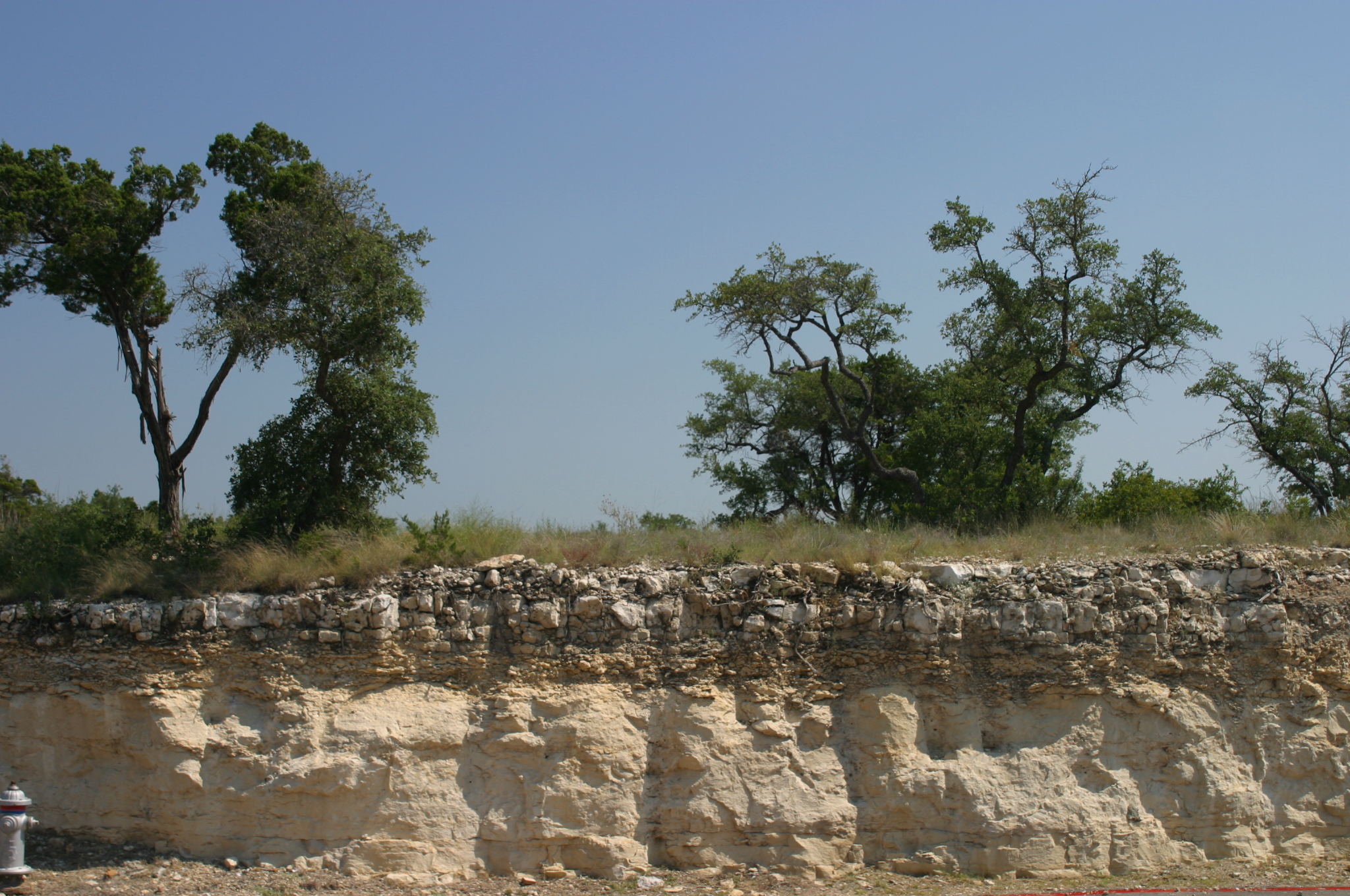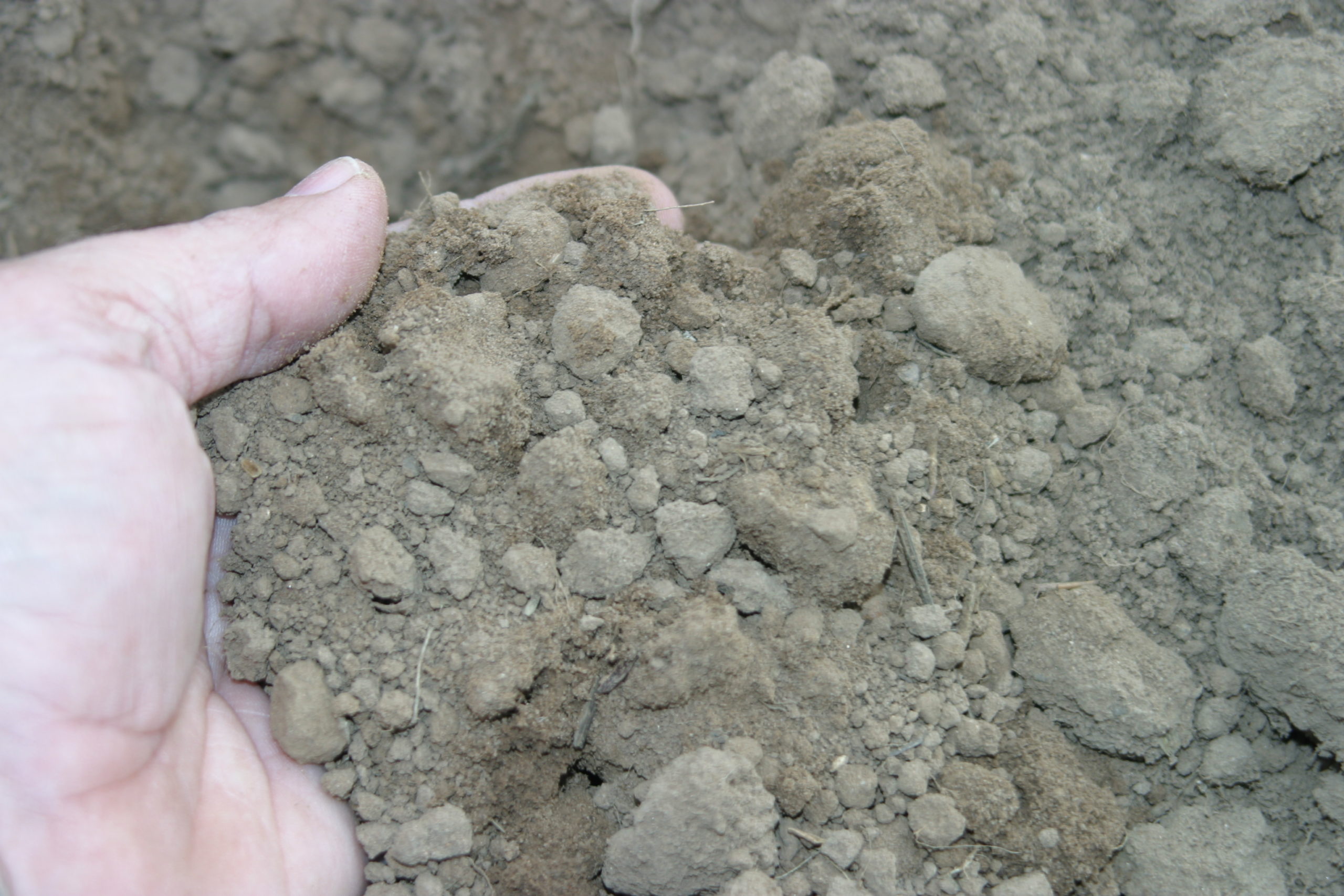The Austin area is home to three ecoregions that have very different types of soil; the Edwards Plateau, the Blackland Prairies, and the Post Oak Savannah Floodplains. All of them are somewhat alkaline, have challenging clay issues, and are low in organic matter. We’ll describe each region to help you identify which one you are gardening in and give you some tips for success. Here is a link to Soil Survey of Travis County Texas if you want to deep dive even further to see the variability in the Austin area soils.

Edwards Plateau Description and Gardening Strategies

The Edwards Plateau is characterized by thin soils on top of exposed limestone
I-35 helps to physically separate the western Edwards Plateau from the eastern Blackland Prairies region here in Austin. This is the reason that garden center employees and the Travis County Master Gardeners ask you which side of the freeway you live on!
You know you’re on the Edwards Plateau if you can observe the following:
- Exposed Limestone
- Soil contains large amounts of crumbled limestone, referred to as calcareous rubble
- Clay soil prevalent
The biggest challenge is not having enough soil. Sometimes builders will bring in soil for new housing developments, but it’s usually not very much and sometimes can be from poor materials like sandy clay. Your best bet is to prioritize what you want to grow and think of your landscape as planting islands. Planting islands allow you to concentrate on soil improvement or find affordable ways to purchase more soil.
Slow Down Runoff
The thin soils and elevation changes contained on the Edwards Plateau make this area prone to runoff. Evaluate your gardening site for ways to slow down the runoff. You can do this with physical barriers, tiers, raised beds, and retaining areas like rain gardens. Utilize materials like larger stones and coarsely ground mulch for transition zones to help prevent decomposed granite or soil mixes from washing away. Summer and Winter cover crops also help stabilize things and keep bare soil in place. An added benefit is that roots help to break down limestone. The clumping and fibrous nature of native prairie grass roots are also good plant choices to help break down limestone.
Add Organic Matter for Soil Health
All clay soils are deficient in organic matter, and especially so on the Edwards Plateau. But the trick is not to go overboard. Your garden soil should contain at least 30% by volume of real soil. This mineralized content is vital for plant health. If you need to purchase soil, make sure that it is not a soilless mixture like a potting mix. Look for words like “top soil” and ask to see the ingredients listing.
Improve the soil that you have with one to two inches of compost added to the topsoil each spring and fall. You’ll also want to retain soil moisture by using three inches of mulch. These thin soil layers leave plants susceptible to summer drought when the root zone can quickly deplete the soils limited moisture reserves. The mulch will eventually break down and become compost, so you may need to add more each planting season. When applying mulch, be sure to give your plants some space by allowing a gap between the mulch and the main stems of the plant.
The Blackland Prairies Description and Gardening Strategies
The black and reddish clays of Central Texas are deep, dense soils that pack tightly into a heavy mass. They absorb water very slowly and have little interior air space making it a tough go for plant roots trying to get a foothold. The good news is that clay soils tend to retain moisture once they’ve absorbed it and don’t easily wash away.
Blackland Prairies can be recognized by the following:
- Wet soil is extremely difficult to remove from tools
- Soil holds it shape in your hand, feels like pottery clay
- Soil profile is very deep, solid rock rarely found
The biggest challenges for these soils are mud and dried areas resembling concrete. They tend to shrink and swell when exposed to moisture, forming wide cracks and heaving objects like fence posts and patios. You can improve the soil over the long term, but if in a hurry, you can garden on top of the clay utilizing raised beds or berms. A common mistake made with clay soils is creating impervious planting holes. This is caused from digging out the hole and filling it with compost or peat moss instead of the soil that came out of it. Amending soil in this way while installing plants will create mini swimming pool holes that retain excess water and girdle roots.
Don’t Add Sand to Clay Soils!
For many people, it seems like you can solve clay soil problems by adding sand or other aggregates. Don’t do this! Clay will bind the larger particles together, and when dry, will form something resembling concrete, mortar, or adobe. There is one material that can be used, and that’s expanded shale. Expanded shale is mined from special types of clay, then heated in kilns until it becomes a porous ceramic aggregate. It doesn’t bind with the clay and it’s porosity helps with aeration and moisture retention. The manufacturing process adds cost, so it is usually more expensive than other soil amendments.
Create Healthy Soil with Organic Matter
The best way to improve clay soil is to add organic matter. There are two primary ways to do this: cover crops and compost.
Cover crops are usually some sort of leafy or grassy forage plant like clover or beans that are meant to be left and decomposed by soil microorganisms. You can turn the crop into the soil, or use the “cut and drop” method to leave it on top as mulch. Common winter cover crops for Central Texas are Fava (sometimes called Windsor or Broad) beans, cereal or elbon rye, wheat, any brassica (like mustard or turnips,) and crimson clover (which needs to be inoculated with rhizobium.) In summer, use crops like hairy vetch, cow or cream peas, and black-eyed peas. An added benefit of growing the peas is that you can harvest the crop before tilling the residue into the soil.
Compost is the best way to improve clay soils, and can be the most cost effective since you can make it yourself. Maintain soils with two to three inches of compost each spring and fall by working it in lightly on top (we call this “scratching it in.”) Mulching is also a good idea to hold in soil moisture, with the added bonus that soil microbes eventually convert it to compost.
The Post Oak Savannah Floodplains Description and Gardening Strategies
Along the river bottoms across the area and the broad plains to the southeast of Austin the soils are often deep sandy loams. They absorb water well, drain well, but don’t hold soil moisture. These soils, like all soils in our area, are usually low in organic matter content and have an alkaline pH.
The characteristics of Post Oak Savannah soils are as follows:
- Terrain is relatively flat and is mostly east of I-35, commonly found along river and creek bottoms where water moves along broad channels
- Soil is loose and drains extremely fast and has difficulty retaining moisture
- Clay hardpan promotes flooding
- Soil will not hold a shape in your hand and mounds quickly flatten, very few visible clods
The biggest challenge in this ecoregion is flooding. These soils are typically sitting on top of a hard layer of impervious clay, which quickly saturates and floods. Flooding usually results in the soil being lifted and moved. Keep this in mind when designing your landscape and consider using structures like planting boxes or retaining walls to hold soil in place and reduce erosion. Utilize ornamental grasses or other perennial plants with fibrous root system to collect and hold silt after downpours.

Loam soil from the Colorado River bottom
Moisture Management is Key
The frustrating part of gardening on the Post Oak Savannah is that when it’s not flooding it’s bone dry! Proper moisture management plays a key role for successful gardening, and the practices are slightly different than what is recommended for the other two ecoregions. Mulching helps a great deal, but be careful to monitor the soil underneath for excessive dryness. Drip irrigation under the mulch makes sure that plants are delivered the moisture they need. If you must do overhead watering, make sure to pull back the mulch so that the water gets to the roots, then rake it back in place once the water is turned off. Don’t depend on natural rainfall to do the job since it may not permeate the mulch layer.
Keep Adding Compost
The sandy soils of the Post Oak Savannah are usually deficient in organic matter because it floods away or is quickly consumed by microorganisms. As a result, use a heavy hand when adding compost in the spring and fall (up to four inches) and monitor the rest of the year to see if more should be added. No matter what, retain a ratio of at least 30% soil to compost.
Strategies for all Three Areas
If you want to be successful at growing things in Austin area soils, some soil improvement is needed. The two key things most often needed are compost to improve the quality of soil and more usable soil depth to support a strong, extensive and resilient root system. A soil depth of 6” is minimal for lawn grasses but more is better. Turf on shallower soils will be weak and require constant watering just to keep it alive. Flowers and vegetables also need 6-12” inches of soil to do well. Building up raised planting beds can turn a shallow rocky soil or one with an impervious clay layer into a beautiful garden spot.
Keep in mind that plants native to this area or areas with similar soil conditions do not require as much soil preparation to thrive here.
Our central Texas soils are usually high in pH levels making them well suited to our western native plants and ill adapted to acid loving plants of the southeast like azaleas and blueberries. Our soils typically have high levels of phosphorus and potassium but may need some additions of nutrients for optimum plant growth. The best way to tell what your soil needs is to have it tested before you apply fertilizers. Instructions on how to take a sample, where to send it, and cost can be found at Texas AgriLife Extension Service Soil, Water and Forage Testing Laboratory Department of Soil and Crop Sciences.
Cover crops can also be utilized to add organic matter and keep soil in place. Here is a link for more information on common cover crops.
No Green Thumbs, Just Great Soil
It doesn’t matter what color you think your thumb is. Everyone can be successful once you’ve identified what type of soil you have and adopt practices to maintain soil health.
Additional Resources for Soils and Composting
Soils and Composting for Austin
Texas A&M AgriLife Extension Soil, Water, and Forage Testing Laboratory
Fertilizer Calculator (once you have your soil test results)
